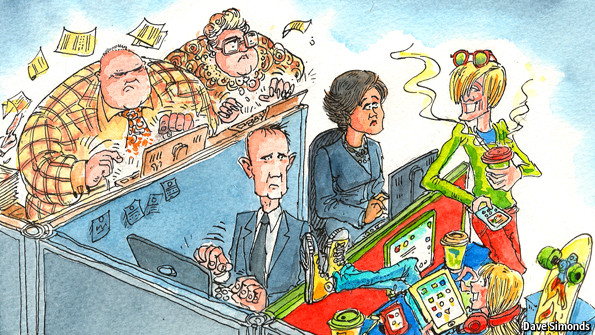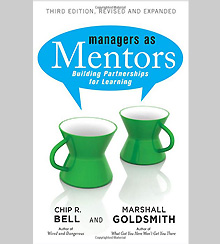- Relate whenever you can. View every interaction as an opportunity to get to know someone a little better. Make a habit of asking employees one question about their work or their personal lives each time you encounter them.
- Take note of subtleties. People seek emotional connection through countless small “bids” for attention—questions, gestures, or looks. Take stock of how much you notice these cues . You might also solicit some feedback from friends and family on how well you listen and respond to social cues in general.
- Regularly express appreciation. Research shows that the ratio of positive to negative interactions is 5:1 in a successful relationship. You don’t need to pay someone five compliments before offering criticism, but do be mindful of the ratio.
Adapted from the HBR Guide to Coaching Your Employees.
Generations in the workplace
Businesses are worrying about how to manage different age groups with widely different expectations

“WHY do you pander to them?” This question kept being put to Marian Salzman, the boss of Havas PR, by her older workers in the days after the firm launched its latest recruitment advertisement. Featuring eager young things using snazzy mobile devices, the ad highlights the company’s lack of hierarchy, and how recruits can choose their own work and talk back to their bosses, as they begin their “personal development journey”.
Although huge numbers of young people today are starting their working lives in one of the least welcoming labour markets in modern history, those with the right skills have never had it so good. Employers have become convinced that they are at the start of a period of famine, and that the best talent has to be won at almost all costs. Furthermore, in some rich countries older workers are retiring later, so bosses have a wider range of ages to manage. But as firms seek to be more meritocratic with promotions, older staff can be dismayed to find that their years of service no longer guarantee advancement; and that as digital skills become more important, younger workers are whizzing past them.
Rolling out the red carpet for Generation Y (those born since the early 1980s) is fuelling in companies everywhere the same sort of intergenerational grudges as at Havas PR, says Ms Salzman. “Baby-boomers really resent these kids,” she says. And Generation X (born in the mid-1960s to early 1980s) is fed up of being “stuck in the middle between older workers who refuse to retire and younger ones who are treated far better than they ever were.”

Generation gaps are as old as history. Nevertheless, businesses seem to be more worried than before about managing three age groups with such differing attitudes. A recent survey by Ernst & Young, which asked American professionals from each age group their opinions of each generation, found significant differences, not all of them predictable (see chart). Baby-boomers, born between 1946 and the mid-1960s, are not slacking off as they age; they are seen as hard-working and productive. The middle ranks of Generation X-ers, who might be expected to be battling their way up the corporate ladder, are viewed as the best team players. Opinions on the youth of Generation Y, also known as “millennials”, are less surprising: good at tech stuff but truculent and a bit work-shy.
Ernst & Young conducted its survey not just for clients; the consultancy felt it needed to understand generational challenges in its own workforce, says Karyn Twaronite, a partner who oversaw the work. In America its staff are young: 62% are from Generation Y, 29% are from Generation X and just 9% are baby-boomers. To get them to work together rather than glowering at each other across their cubicle dividers, the firm is encouraging them to do voluntary work in cross-generational teams. Millennials may be cool with this; their older peers not so much.
Despite the millennials’ mixed reviews, many of their number have enjoyed swift promotion into managerial positions. Being “digital natives” has helped them overtake older candidates in jobs where understanding of such things as social media helps. Employers may also be promoting them because of three characteristics that often show up in surveys of millennials’ attitudes: their demands to be treated meritocratically, their appetite for responsibility and their unwillingness to hang around if they do not get what they want.
However, the growing trend of workers reporting to younger managers raises the question of how to keep the older lot motivated. Working under a youthful supervisor, older subordinates are constantly reminded that they have failed to keep pace, argue Florian Kunze of the University of St Gallen and Jochen Menges of Cambridge University in a paper presented at the recent annual meeting of America’s Academy of Management. The more talk there is in a workplace about comparisons between the generations, the academics suggest, the more destructive the negativity of those passed over.
The labels for the three age-groups largely reflect America’s demography. But firms are also fretting about generational issues in fast-growing emerging economies with young populations, such as India. After its rapid expansion in recent years, Tata Consulting Services (TCS) now has a 240,000-strong workforce of which over 70% are under 30. This has put enormous pressure on the firm to change, says Ajoy Mukherjee, its head of human resources. Feedback on performance is given more quickly, and junior employees are given more responsibility sooner.
TCS has also launched Knome, an internal social network inspired by Facebook and Twitter, because younger workers wanted it. This has facilitated collaboration on everything from designing valuable new software to, yes, volunteering in the community. “There is no point in baby-boomers and Generation X saying that Gen Y should behave like us. We have to behave like them,” says Mr Mukherjee.
One reason for optimism is that some of the things that supposedly make Generation Y different have been exaggerated, says Rich Floersch, head of HR at McDonald’s. In fact, they are “irked by the myths of having a sense of entitlement, having poor communication skills and being job-hoppers.” If they find a company that offers challenging work, a sense of purpose and development they will stay, he adds.
When a millennial is using her smartphone in a meeting, she may be multitasking, rather than disengaged or rude, argues Dan Schawbel, who has just written a book about Generation Y at work. She may be resented by her older colleagues, but typically she respects them and wants to learn from them. That explains millennials’ constant pleas for feedback, says Mr Schawbel. Baby-boomers and Generation X–ers may find mentoring millennials rewarding—if they give it a try.
Google is often portrayed as the embodiment of millennial-friendly work practices. But Laszlo Bock, a human-resources chief at the internet firm,, points out that it has workers as old as 83. And he argues that the only thing different about Generation Y is that it is actually asking for the things that everybody else wants.
Maybe. But how many firms will be as willing and able as Google to pamper its staff to keep all the generations rubbing along more or less happily?



![[image]](http://si.wsj.net/public/resources/images/OB-ZB840_oldsch_DV_20130927172619.jpg) Kupchynsky Family
Kupchynsky Family![[image]](http://si.wsj.net/public/resources/images/RV-AL680A_OLDSC_DV_20130927221650.jpg) Luci Gutiérrez
Luci Gutiérrez![[image]](http://si.wsj.net/public/resources/images/RV-AL670_OLDSCH_DV_20130927183906.jpg) Arthur Montzka
Arthur Montzka

 By Lucy Kellaway
By Lucy Kellaway By Gillian Tett
By Gillian Tett ©Shonagh Rae
©Shonagh Rae
 ©Laura Carlin
©Laura Carlin



